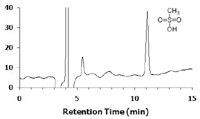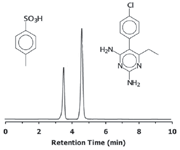Organic Acid Counter Ion Analysis using a Bonded Zwitterionic Stationary Phase
Using a bonded zwitterionic stationary phase, ZIC?-HILIC, polar organic acid counter ions such as methylsulfonic acid can easily be retained, to aid simultaneous analysis of basic pharmaceutical APIs together with their counter ions.
Using a bonded zwitterionic stationary phase, ZIC®-HILIC, polar organic acid counter ions such as methyl sulfonic acid can easily be retained, to aid simultaneous analysis of basic pharmaceutical APIs together with their counter ions.
Often pharmaceutical formulations are stabilized with inorganic or organic counter-ions, to influence different parameters such as solubility and stability. Appropriate counter-ion choice is an important part of the drug development process and quantitative and qualitative analysis is required for both the active pharmaceutical ingredient (API) and the corresponding counter-ion. Common counter-ions are: chloride, bromide, nitrate, ammonium, sulfate, tosylate, phosphate, tartrate, ethylenediamine, and maleate. Ion chromatography (IC) with conductivity detection has been used to analyze these counter-ions, but dedicated individual IC methods are required for each suite of analytes. Hydrophilic interaction liquid chromatography (HILIC) has emerged as an attractive alternative to IC, and with the use of a bonded polar zwitterionic stationary phase it is possible to analyze inorganic cations and anions, organic acids and bases, alone or simultaneously with polar and hydrophilic APIs using different detection techniques. Applicability to these most common counter-ions has already been presented elsewhere (1–3).

Figure 1: 20 μL injection of 200 ppm methanesulfonic acid in mobile phase on a 150 à 4.6 mm ZIC®-HILIC column (3.5 μm/100 à particle) using a 80:20 (v/v) acetonitrile and 100 mM ammonium acetate (pH adjusted to 4.5 with acetic acid) mobile phase. Detection was performed with RI (Cell temp: 40 °C, Range: 1.0) and the column temperature was 40 °C.
In this application note two additional commonly used counter-ions are presented. Methylsulfonic acid is retained in HILIC mode and monitored using refractive index (RI) detection, as shown in Figure 1. The analysis of counter-ion together with the API is presented in Figure 2, where a simultaneous ZIC®-HILIC separation of paratoluenesulfonic acid (PTSA) and a basic API, pyrimethamine, is shown. Both of these applications can easily be adapted to MS detection, or simply add a post-column flow splitter to a MS detector for further characterization of the API.

Figure 2: 1 μL injection of 100 ppm of each paratoluenesulfonic acid and pyrimethamine in mobile phase on a 150 à 4.6 mm ZIC®-HILIC column (5 μm/200 à particle) using a 90:10 (v/v) acetonitrile and 10 mM ammonium acetate (pH 6.8) mobile phase. Detection was performed with UV at 254 nm and the column temperature was 25 °C.
Conclusions
Separation of polar and hydrophilic compounds like methanesulfonic acid is easily achieved in HILIC mode, but also more hydrophobic compounds like paratoluenesulfonic acid is straightforward when using a bonded zwitterionic stationary phase. This application note illustrates how ZIC®-HILIC columns can aid the determination of APIs and their organic acid counter-ions.
References
(1) D.S. Risley and B.W. Pack, LCGC North America 24(24), 776–785 (2006).
(2) Z. Huang, M.A. Richards, Y. Zha, R. Francis, R. Lozano, and J. Ruan, J. Pharm. Biomed. Anal. 50, 809–814 (2009).
(3) http://www.sequant.com/applicationnotes
EMD Millipore, An affiliate of Merck KGaA,
Darmstadt, Germany
480 South Democrat Road, Gibbstown, NJ 08027
tel. (800) 222-0342; Website: www.emdchemicals.com

SEC-MALS of Antibody Therapeutics—A Robust Method for In-Depth Sample Characterization
June 1st 2022Monoclonal antibodies (mAbs) are effective therapeutics for cancers, auto-immune diseases, viral infections, and other diseases. Recent developments in antibody therapeutics aim to add more specific binding regions (bi- and multi-specificity) to increase their effectiveness and/or to downsize the molecule to the specific binding regions (for example, scFv or Fab fragment) to achieve better penetration of the tissue. As the molecule gets more complex, the possible high and low molecular weight (H/LMW) impurities become more complex, too. In order to accurately analyze the various species, more advanced detection than ultraviolet (UV) is required to characterize a mAb sample.

.png&w=3840&q=75)

.png&w=3840&q=75)



.png&w=3840&q=75)



.png&w=3840&q=75)














